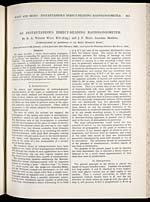Robert Watson-Watt (1892-1973)
An instantaneous direct-reading radiogoniometer
WATT AND HERD: INSTANTANEOUS DIRECT-READING RADIOGONIOMETER.
611
AN INSTANTANEOUS DIRECT-READING RADIOGONIOMETER.
By R. A. WATSON WATT, B.Sc. (Eng.), and J. F. HERD, Associate Members.
[Communicated by permission of the Radio Research Board.]
(Paper first received 6th January, and in final form 12th February, 1926; read before the WIRELESS SECTION 3rd March, 1926.)
SUMMARY.
The paper describes a visual direct-reading radiogonio-
meter capable of indicating the apparent azimuth of arrival
of wave-trains the durations of which need not exceed
0·001 sec. The special properties of the device, which com-
prises essentially a combination of directional aerials with
a cathode-ray oscillograph, are discussed. Amongst these
properties is that of giving simultaneous bearings on two or
more stations transmitting simultaneously on the same
wave-length. A typical installation is described, and speci-
mens of observations on the distribution in azimuth of
received atmospheric disturbances are shown. A possible
solution of the problem of navigational beacons is suggested.
_____________________
I. INTRODUCTION.
The defects and limitations of radiotelegraphic
direction-finders of the types in commercial use have
now been clearly realized and frequently enumerated.
Some of these defects are inherent in the use of the
simple vertical loop as a receiving element, since multiple-
ray effects are then liable to produce errors in the appa-
rent azimuths read by the instrument. Other defects
are peculiar to the means adopted for determining this
apparent azimuth.
The work on which the authors are engaged, the
investigation of the nature and origin of atmospherics,
is peculiarly suited to call attention to these defects.
The directional side of the investigation is concerned
with the determination of the place of origin of electro-
magnetic disturbances which are arriving in very rapid
succession from very diverse azimuths, from distances
ranging from a few miles up to or exceeding the earth's
semi-circumference, with peak field strengths varying
from several volts per metre down to the lowest measur-
able values, with durations varying widely about a
mean of the order of a few thousandths of a second,
and of diverse forms.
The standard forms of radiogoniometer have been
applied to the study of this heterogeneous distribution,
and although the results of such applications have been
very illuminating, one can only express surprise that
they should have yielded data capable of interpretation.
The rotating-loop method—embracing the Marconi-
Bellini-Tosi-Artom radiogoniometer with its ingenious
method of rotating a large “ effective loop ” by means
of a small search coil, the single-coil direction-finder,
and the Robinson crossed-coil instrument—is not well
suited for work on any signal other than a simple wave-
train sustained or repeated over a period of the order
of several seconds, from a sensibly stationary source,
and free from interferent signals capable of producing,
in the loop, electromotive forces amounting to so little
as ½ of 1 per cent of the maximum electromotive force
from the desired signal. The inertia of the moving
elements prevents the taking of bearings on brief
wave-trains, or on wave-trains the apparent azimuth
of which is varying at a rate exceeding a limit which
may be generously estimated at 1° per sec. The form
of the cosine polar curve is such that only the position
of minimum electromotive force can be used for accurate
determinations, and ensures that any interferent train
capable of producing E.M.F.'s of the same order of
magnitude will effectively mask this minimum when
the apparent azimuths of desired and undesired signals
differ by 60° or more, whilst much weaker signals from
azimuths within 20° of the minimum will also mask
the latter. Thus it is certain that at the best this type
of direction-finder will, when applied to the study of
atmospherics, merely indicate the mean apparent
directions of arrival of the predominant streams of
atmospherics, and that there is always a high probability
that two physically independent streams will be merged
into one statistically true but physically fictitious
stream in the indications of the instrument., When to
these defects we add the extreme crudeness of the
discrimination in amplitude afforded by aural reception,
or by any simple recording system, it is abundantly
clear that there is a pressing need for radical changes
in direction-finding apparatus in general, and in that
used in the study of atmospherics in particular.
The ideal radiogoniometer would record the true
azimuth of arrival, i.e. the horizontal projection of the
direction of propagation at the point of incidence on
the receiver, of any desired signal, of whatever form or
magnitude, and however brief its duration, and would
at the same time record at least one fundamental
parameter determined by peak field strength or one of
its derivatives. The indication should be independent
of the presence of simultaneously incident signals of
any form or distribution.
The purpose of the present paper is not to describe
the ideal instrument, but to describe a device which is
believed to be a much closer approximation to that
ideal than were its predecessors.
II. DESCRIPTION.
The general principle of the device is almost too
simple to require detailed notice. Consider, for example,
two loop aerials, A and B, identical in every respect,
with their planes vertical and at right angles to one
another. Then a vertical wave-front, in which the
maximum vertical electric force is E, and the ray
direction of which makes an angle ψ with the plane of
loop A, will produce E.M.F.'s proportional to E cos ψ


